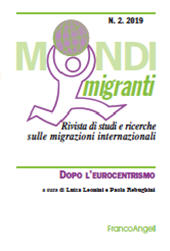Trying to make it a home : an analysis of the opportunities asylum seekers have in order to develop long-lasting emplacement processes in South Tyrol, Italy
129-147 p.
The document discusses the opportunities for asylum seekers to build emplacement processes. In this way, it supports a double understanding of personal placement processes, which implies a consideration of both the subjective level of action and the social environment that can hinder or improve the experience of personal placement of an asylum seeker. From April 2016 to March 2017 25 interviews were conducted with asylum seekers in South Tyrol Data analysis is based on a qualitative research project, which follows an inductive research approach and adopts an approach of mixed qualitative methods: semi-structured interviews , narrative interviews, observation of the participants and group discussions As this document shows, to understand the duality of the processes of emplacement it is fundamental to understand the interaction between the subjective abilities of indi-viduals to act and make their own choices and the structural circumstances that determine,
limit or enable such actions Job opportunities are one of the central elements of it the promotion of social integration. Work in this context is seen not only as an economic activity that allows asylum seekers to earn money and sup-port the remaining family members, but also as a way to overcome idleness and inactivity. [Publisher's text].
Il documento discute le opportunità dei richiedenti asilo di costruire processi di emplacement. In tal modo, essa sostiene una doppia comprensione dei processi di collocazione personale, che implica una considerazione sia del livello soggettivo dell'agire che dell'ambiente sociale che può ostacolare o migliorare l'esperienza di collocamento personale di un richiedente asilo. Da aprile 2016 a marzo 2017 sono state effettuate 25 interviste con richiedenti asilo in Alto Adige. L'analisi dei dati si basa su un progetto di ricerca qualitativo, che segue un approccio di ricerca induttivo e adotta un approccio di metodi qualitativi misti: interviste semi-strutturate, interviste narrative, osservazione dei partecipanti e discussioni di gruppo. Come mostra questo documento, per comprendere la dualità dei processi di emplacement è fondamentale comprendere l'interazione tra le capacità soggettive degli individui di agire e fare le proprie scelte e le circostanze strutturali che determinano,
limitano o abilitano tali azioni. Le opportunità di lavoro sono uno degli elementi centrali nella promozione dell'integrazione sociale. Il lavoro in questo contesto è visto non solo come un'attività economica che consente ai richiedenti asilo di guadagnare denaro e sostenere i familiari rimasti, ma anche come un modo per superare l'ozio e l'inattività. [Testo dell'editore].
Ist Teil von
Mondi migranti : 2, 2019-
Artikel aus derselben Ausgabe (einzeln erhältlich)
-
Informationen
ISSN: 1972-4896
KEYWORDS
- Richiedente asilo, dislocamento, collocazione, integrazione sociale, opportunità
- Asylum seeker, displacement, placement, social integration, opportunities



